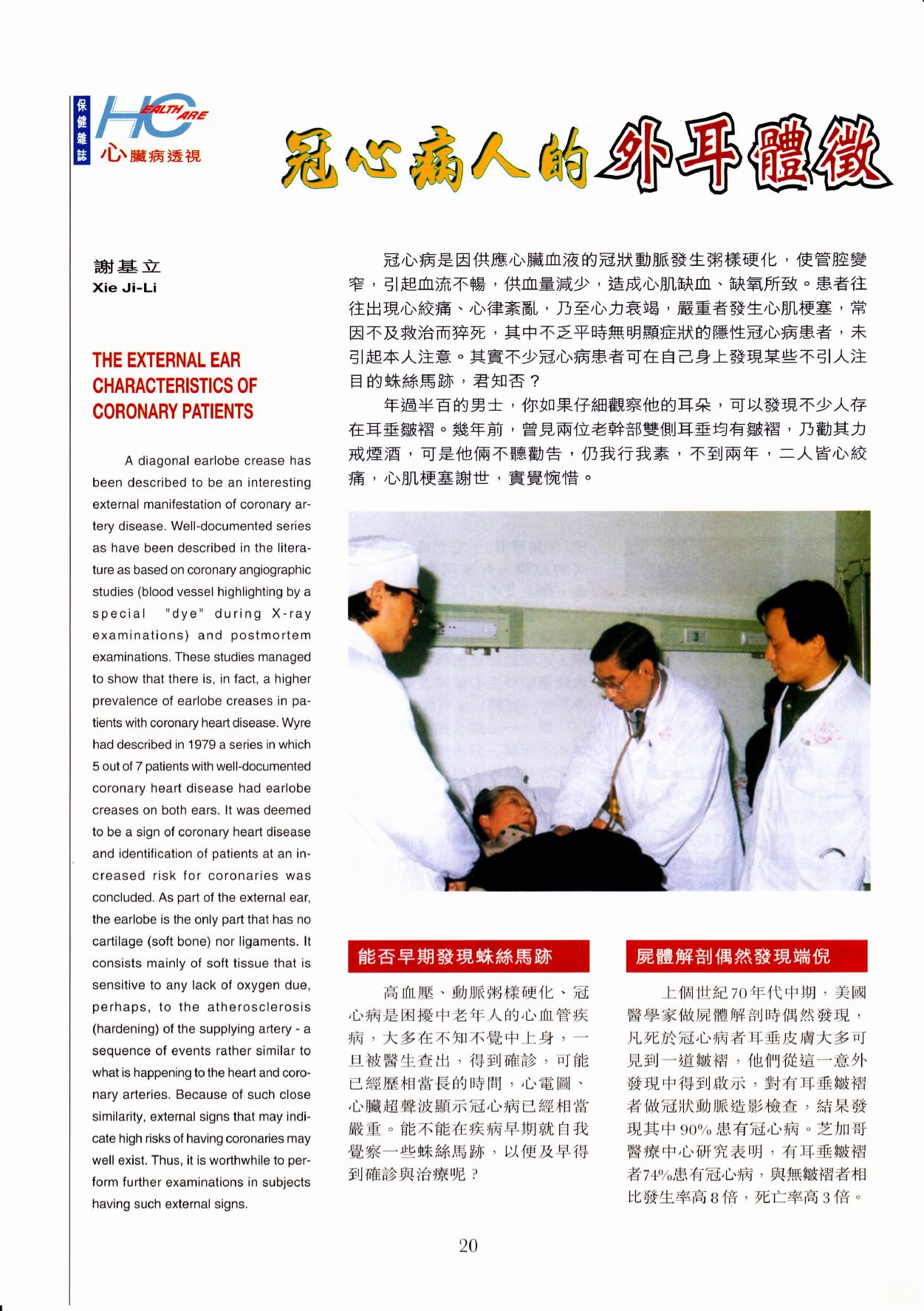
H
ffiffi&&ffi
HfrrE
.
FiEJRtriAtfrF IU.
-
7$.
ffi
,
f?ET+nZ^H.+
LH
,
-
a4fr.ffi+.Efr
,
l+Ttln€i'
'FJAE
E#gtrfHHEF!F+F{
'
,1.€El
.
,
t'
ffi ffi H
itrffi
z\
ff
,L'
ffi
=
kqt1H
H.*-
tiq*,WEtf
,
v)IF.&.+l+
?\68:--,rg4hffiw t
,D.mm;aa
#JElN
Xie
Ji-Li
THE EXTERNAL
EAR
CHARACTERISTICS
OF
CORONARY
PATIENTS
A diagonal earlobe crease
has
been described
to
be
an
interesting
external manifestation
of
coronary
ar-
tery disease. Well-documented series
as have been described
in
the litera-
ture
as
based
on
coronary angiographic
studies
(blood
vessel highlighting
by
a
special
"dye"
during
X-ray
examinations) and
postmortem
examinations. These studies managed
to show that there is,
in
fact, a higher
prevalence of earlobe creases in
pa-
tients with
coronary
heart disease.
Wyre
had described in
1979 a
series
in
which
5 out of 7 patients with
well-documented
coronary heart disease had
earlobe
creases on both ears. lt was
deemed
to
be a
sign
of
coronary
heart disease
and identification of patients at an
in-
creased risk
lor
coronaries
was
concluded. As part of
the
external
ear,
the
earlobe
is
the only part
that
has no
cartilage (soft bone) nor ligaments.
lt
consists
mainly
of soft tissue that
is
sensitive
to any lack of
oxygen due,
perhaps,
to the
atherosclerosis
(hardening)
of
the supplying
artery - a
sequence
of events
rather similar to
what
is
happening
to
the
heaft and
coro-
nary arteries. Because of such close
similarity, external signs
that
may indi-
cate
high risks of having
coronaries may
well exist. Thus, it
is
worthwhile to per-
form further examinations
in
subjects
having such external signs.
€'
ElEmffi,TW,
IRfr=adn'y, €Fl,L.flJlftlm
.
ftifiFfar.
"
E+E
tr T
e.f.{)A
ffifrrE'
H
+
TZ+
E+ft
EE
RFEfrt
f!
lHltE,t )8.e.#'
^
E
I
ft
E
A
,\
)+
F
"
H
H
T
r'
E,
b,6
F.
4
al
fx.
e
e
H
L#rE
H
jlb
T
E
I
E
trilletf"(ffiMf
, E-Ft6
?
+,E
+
H
H!
E
+,
fA':E
F=1+
AfrEBF{&
H!
E
+'
EJ
I)(
EF
ET''
AE
,E
'
,bflftiFE-#U '
HH'lrdlH
"
i'fEH,4d,70+,ft+H,+E
ffi
ry
xft\ffi,€g
fi4 *|J
F+iE
f*4FrE,
ItEDtE,L.
ffih4,+E
E)t4
trI
n3tl
-
€HfrIH'
IMIFI'#.€-
-e.*
4F
4Frfr.+
1+4tJ
E
.r;'
gf
A4+
frfi
iH
A
fifr\ffi,tt6h
flfr#-"Ee
tkA,
F" R4E
IF,4+
so"/"
ffi,HTE,L'fr
. Z)Jnfr
gffi
+'L'6tr
fr
#-BE,
H H'&F'friH
#
t
+"t",E
H
7$,,
L.)fi
,
WffifrF+H
E
tH
LL4*+4H
Bl* '
tn-Ara
s'f*
"
20


